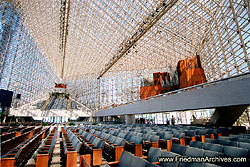CHURCHES: MODERNITY
The Protestant Reformation, which emphasized the word of God above all else (sola scriptura) was mistrustful of exaggerated material manifestations of Christian piety: The embodiment of human-divine connection in buildings, and the lavish imagery of medieval stained glass, seemed to veer too close to "idolatry" for the Protestant Reformers. To the Reformers, the cathedrals of the Roman Catholics seemed more like earthly palaces (fitting, they said, for the power-hungry popes) than true houses of worship.
In their public Christian architecture, Protestants embraced a mode of simplicity and necessity. The "little white churchhouse" that characterized Puritan New England derives from this gesture towards simplicity and away from material extravagance:
This church in New Jersey is typical of the plain, white, clapboard front church that portrays a serene, nonmaterialistic "face" of public Christianity. The shuttered windows, and the rose window in the steeple, invoke--but correct--the stained glass extravagance of the Middle Ages.
But the "public face" of Christianity in the United States, especially, turned towards expressions of cultural triumph and a different kind of extravagance after World War II (especially since the 1960s). As Christianity moved increasingly into the public square, the style of church architecture became accordingly "big": Christianity began portraying itself as a force to be reckoned with.
 This
is an interior view of the "crystal cathedral" in Los Angeles: an almost
disorienting array of colors, shapes, and angles meant to invoke (like the
medieval cathedral) the majesty of God, and the intersection of the human and
divine on earth; but also meant to portray the presence of Christianity in the
public square.
This
is an interior view of the "crystal cathedral" in Los Angeles: an almost
disorienting array of colors, shapes, and angles meant to invoke (like the
medieval cathedral) the majesty of God, and the intersection of the human and
divine on earth; but also meant to portray the presence of Christianity in the
public square.